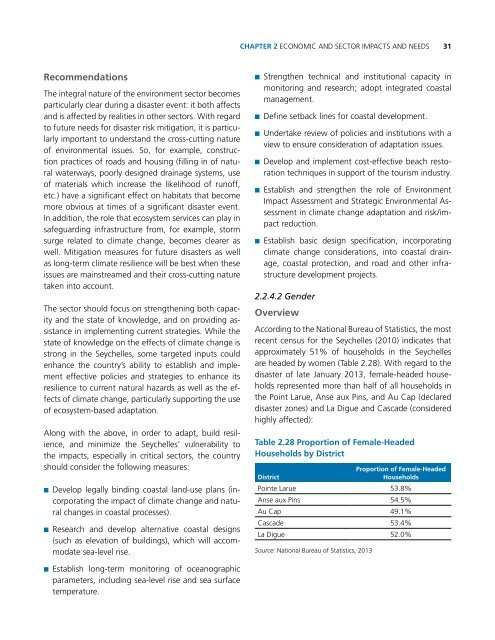Seychelles Damage, Loss, and Needs Assessment (DaLA ... - GFDRR
Seychelles Damage, Loss, and Needs Assessment (DaLA ... - GFDRR
Seychelles Damage, Loss, and Needs Assessment (DaLA ... - GFDRR
You also want an ePaper? Increase the reach of your titles
YUMPU automatically turns print PDFs into web optimized ePapers that Google loves.
CHAPTER 2 Economic <strong>and</strong> Sector Impacts <strong>and</strong> <strong>Needs</strong><br />
31<br />
Recommendations<br />
The integral nature of the environment sector becomes<br />
particularly clear during a disaster event: it both affects<br />
<strong>and</strong> is affected by realities in other sectors. With regard<br />
to future needs for disaster risk mitigation, it is particularly<br />
important to underst<strong>and</strong> the cross-cutting nature<br />
of environmental issues. So, for example, construction<br />
practices of roads <strong>and</strong> housing (filling in of natural<br />
waterways, poorly designed drainage systems, use<br />
of materials which increase the likelihood of runoff,<br />
etc.) have a significant effect on habitats that become<br />
more obvious at times of a significant disaster event.<br />
In addition, the role that ecosystem services can play in<br />
safeguarding infrastructure from, for example, storm<br />
surge related to climate change, becomes clearer as<br />
well. Mitigation measures for future disasters as well<br />
as long-term climate resilience will be best when these<br />
issues are mainstreamed <strong>and</strong> their cross-cutting nature<br />
taken into account.<br />
The sector should focus on strengthening both capacity<br />
<strong>and</strong> the state of knowledge, <strong>and</strong> on providing assistance<br />
in implementing current strategies. While the<br />
state of knowledge on the effects of climate change is<br />
strong in the <strong>Seychelles</strong>, some targeted inputs could<br />
enhance the country’s ability to establish <strong>and</strong> implement<br />
effective policies <strong>and</strong> strategies to enhance its<br />
resilience to current natural hazards as well as the effects<br />
of climate change, particularly supporting the use<br />
of ecosystem-based adaptation.<br />
Along with the above, in order to adapt, build resilience,<br />
<strong>and</strong> minimize the <strong>Seychelles</strong>’ vulnerability to<br />
the impacts, especially in critical sectors, the country<br />
should consider the following measures:<br />
■■<br />
Develop legally binding coastal l<strong>and</strong>-use plans (incorporating<br />
the impact of climate change <strong>and</strong> natural<br />
changes in coastal processes).<br />
■■<br />
Research <strong>and</strong> develop alternative coastal designs<br />
(such as elevation of buildings), which will accommodate<br />
sea-level rise.<br />
■■<br />
Strengthen technical <strong>and</strong> institutional capacity in<br />
monitoring <strong>and</strong> research; adopt integrated coastal<br />
management.<br />
■■<br />
Define setback lines for coastal development.<br />
■■<br />
Undertake review of policies <strong>and</strong> institutions with a<br />
view to ensure consideration of adaptation issues.<br />
■■<br />
Develop <strong>and</strong> implement cost-effective beach restoration<br />
techniques in support of the tourism industry.<br />
■■<br />
Establish <strong>and</strong> strengthen the role of Environment<br />
Impact <strong>Assessment</strong> <strong>and</strong> Strategic Environmental <strong>Assessment</strong><br />
in climate change adaptation <strong>and</strong> risk/impact<br />
reduction.<br />
■■<br />
Establish basic design specification, incorporating<br />
climate change considerations, into coastal drainage,<br />
coastal protection, <strong>and</strong> road <strong>and</strong> other infrastructure<br />
development projects.<br />
2.2.4.2 Gender<br />
Overview<br />
According to the National Bureau of Statistics, the most<br />
recent census for the <strong>Seychelles</strong> (2010) indicates that<br />
approximately 51% of households in the <strong>Seychelles</strong><br />
are headed by women (Table 2.28). With regard to the<br />
disaster of late January 2013, female-headed households<br />
represented more than half of all households in<br />
the Point Larue, Anse aux Pins, <strong>and</strong> Au Cap (declared<br />
disaster zones) <strong>and</strong> La Digue <strong>and</strong> Cascade (considered<br />
highly affected):<br />
Table 2.28 Proportion of Female-Headed<br />
Households by District<br />
Proportion of Female-Headed<br />
District<br />
Households<br />
Pointe Larue 53.8%<br />
Anse aux Pins 54.5%<br />
Au Cap 49.1%<br />
Cascade 53.4%<br />
La Digue 52.0%<br />
Source: National Bureau of Statistics, 2013<br />
■■<br />
Establish long-term monitoring of oceanographic<br />
parameters, including sea-level rise <strong>and</strong> sea surface<br />
temperature.

















